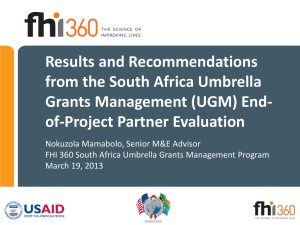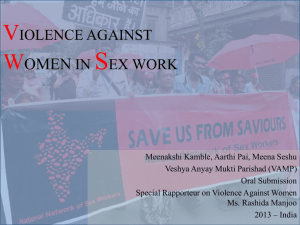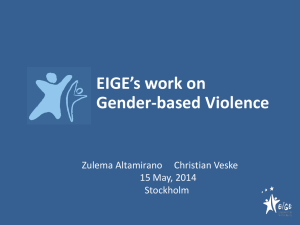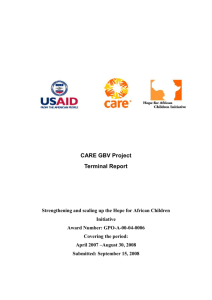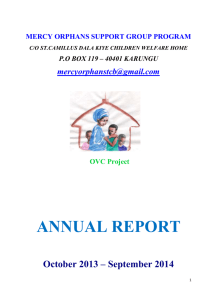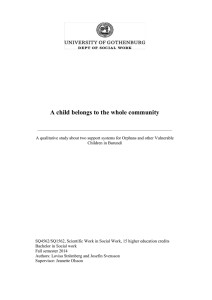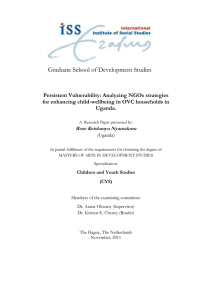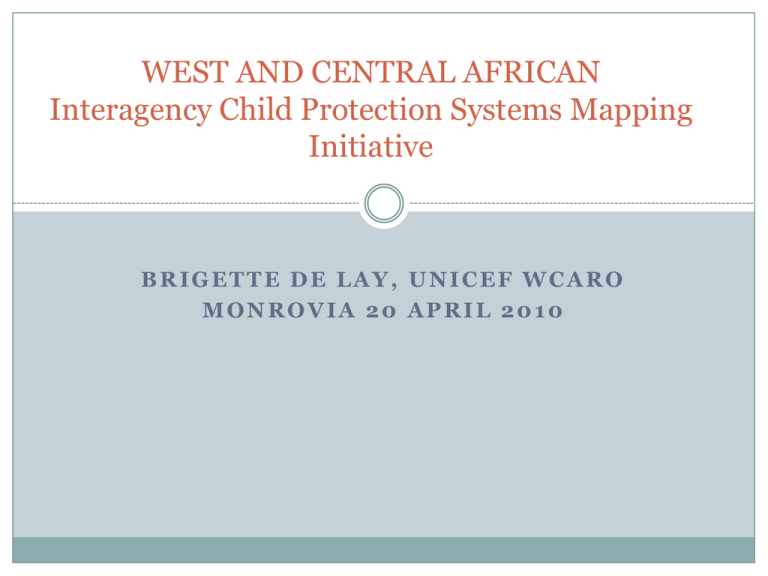
WEST AND CENTRAL AFRICAN
Interagency Child Protection Systems Mapping
Initiative
BRIGETTE DE LAY, UNICEF WCARO
MONROVIA 20 APRIL 2010
Strengthening National Child Protection Systems
2
Where are we coming from…..
Where are we going…
Projects – focus a collection
Programmes – focus on systems
activities
Focus on categories of children –
vertical approached - rescuecharity
building
Focus on all vulnerable children
– not just categories – move
toward horizontal programming
Short term planning – 1-2 year
Long term planning – 5 to 10
Large investment in NGOs, little
Increased
project cycles
investment in state structures –
poor coordination between
actors- fragmented programming
year vision
investment/prioritization in
building gov’t capacity to fulfill
their role as duty bearers
UNICEF
What is a child protection system?
3
Education
and ECD
Social
protection
Livelihoods
&
employme
nt
C4D
Social
Welfare
and
Justice
Health
Civil
registratio
n
UNICEF
Child Protection is Everyone’s Business
4
Health & Protection
IEC campaigns against domestic violence as a public health concern
Health protocols to prevent abandonment and separation of children from their families at health facilities
Detecting and reporting abuse - Linking at risk children and families with social service support
Age appropriate medical and mental health care, treatment and support for victims of violence and sexual abuse
(PEP kits, fistula repair, etc.) – preserving forensic evidence
Education & Protection
Access to all children to education as a protective factor
Promote life skills-based education to strengthen children’s resilience and ability to protect themselves from HIV,
STDs, substance abuse, violence, exploitation, etc.
Combating violence and abuse at school, including sexual violence and grades in exchange for sex
Addressing corporal punishment – sexual abuse and exploitation – bullying
Screening and early detection of abuse , at risk children – reporting and referral of cases to social services
Livelihood and Employment/Social Protection & Protection
Poverty reduction through cash transfers, access to credit, saving schemes, IGA
Vocational training programs for out of school youth and other children at risk of exploitation
Universal Health Care and Free Education
UNICEF
WHERE ARE CHILDREN PROTECTED?
5
Govt
NGOs/CSO
COMMUNITY & FAMILIES
COMMUNITIES, FAMILY, CHILDREN
IMPLICATIONS: Systems work is built on reinforcing both informal and
formal systems and their linkages
UNICEF
Child protection results – services – building blocks
6
UNICEF
Project Overview
Objectives:
At country level, to build a common understanding of what
exists & to identify opportunities & challenges for systems
strengthening
On the regional level, to develop a West and Central African
conceptual framework for child protection systems
Participating Countries: Sierra Leone, Ivory Coast, Ghana,
Niger and Senegal
Methodology: Desk review, survey sector, semi-structured
interviews with key resource persons, case studies – 4 field
sites
Analytical Framework
Analysis of existing system components
(formal and informal)
Analysis of how the child protection system
functions to protect children
Analysis of how the system fits the local
context
Type of information gathered on the formal system:
What exists? Gap? Bottlenecks? Opportunities?
Legislation, Policies, Standards, Regulations
Structures
Services (SW, Justice, Health, Education, Social Protection)
Coordination
Human and Financial Resources
Capacities
Information Management Systems
Type of information gathered on community:
Perceptions, Congruence, Barriers, Linkages
Relationship and linkages between the formal and
informal system
Children’s access to protection services (prevention
and response)
Children, families and communities perceptions of
the formal system
Children, families and communities perceptions on
the impact of the formal child protection
The Ivory Coast Mapping Experience
WHY? To use the mapping to bring a disperse group of
protection actors together & to begin to build an evidence
base to develop a more effective, efficient protection
response (national child protection strategy)
Hosted by Ministry of Social Welfare, with support of
UNICEF and NGOs
International consulting firm + national research team
Focus on rural and urban
Country context continued
Emerging from conflict, slow transition
Poverty level at 48.9% (10% in 1985)
Education system in crisis
51% primary school enrolment ratio
Literacy rate 15-24yrs at 52.8% (down of 6 points)
The health system in crisis
Uneven distribution of services, uneven presence of human resources
21% population used health services (2008)
Justice sector in need of deep reform
Only half of courts and prisons are functioning
Inaccessible system
Key Findings on the Legal and Policy Framework
KF1: Fragmented child protection legal framework; no
comprehensive child protection law; disconnect between
traditional justice systems and formal systems
KF2: Lack of a comprehensive strategic direction on child
protection and family welfare – three driving, but
disconnected strategies
OVC most articulate, but narrow focus , objective is the reach of 800
thousand children
GBV in humanitarian content, piloting new approach – policy,
planned database
Trafficking, mainly on law enforcement and repatriation,
exploitation cases, narrow focus with exceptions, intake guidance
Key Findings continued.....
KF3: Competing approaches – working in isolation –
inefficient use of limited resources for children
OVC, through Social Service Centers as a coordination function, services
provided by NGOs, no sustainability plan, no national standards
GBV, through Social Service Centers/NGOs, referral pathways;
professional networks, comprehensive intake, piloting case
management
Trafficking, Child protection committees, role of the Prefet and law
enforcement, involvement of all local services
Committee against violence on women and children, small scale pilot,
centre d’ecoute (social service centers)
Key Findings on Social Services
KF1: Health playing no role in detection & reporting, weak
response to victims
KF2: Education working in isolation to resolve some protection
concerns, but no prevention dimension
KF 3: Social Service Centers limited in reach, extremely weak,
little evidence of actual service provision
KF4: No logic behind geographic coverage - NGOs scattered,
uneven presence, driven by mandate (OVC, GBV, Trafficking);
Gov’t services only in select areas
MAP 1- Government services
MAP 4 – INGOs VS poverty
Key Findings continued......
KF5: Children and communities in all exemplar community
unable to mention any of the NGOs or Government Services
Child protection committees act as the link with formal
systems, but not fully functional, little evidence of impact,
and often focused on specific child protection issued that are
donor driven (OVC, trafficking, GBV)
Community leaders generally not involved and not playing a
significant role in the formal system
Key Findings on Coordination & collaboration:
National Planning
KF1: There is no child protection national coordination
platform (draft decree) – specific sector coordination bodies
exist, but do not formally interact (OVC, trafficking, GBV,
protection cluster)
KF2: Government priorities largely dictated by donors
Little negotiating power without a national policy
KF3: Lack of collaboration among donors and key agencies
Tightly sealed, siloed sectoral interventions (OVC, GBV, Trafficking)
Overall child protection vulnerabilities not considered
Unrealistic expectations of positively changing the child protection
system through sectoral approaches
Key Findings on Coordination and collaboration:
Referral Mechanisms and Practices
KF1: Referral mechanisms
94% of programmes require collaboration with
other programmes/services
36.8% of them have referral mechanisms and
protocols somehow formalized
42.1% of them work on informal basis
KF2: Frontline workers’ perspective:
28% good collaboration
22% not very good collaboration
41% no collaboration at all
Key Findings on Data Management
KF 1: Separate databases: National database on OVC (one
planned for GBV)
KF 2: There is no standard reporting format for any of the
basic social welfare services
Use of database in Programmes
NO
50%
YES - part of a national
system
6%
YES - internal system
39%
YES - system shared with
other agencies
5%
Key Findings on Human Resources
KF1: Capacity of front line workers
Almost 40% are professional social workers
58% has more than 5 yrs experience (28% one yr or less)
97% received additional training (OVC, GBV, CRC)
KF2: Education and training opportunities
INFS university level education for social workers and
educateurs specialise (approximately 500 per year)
74% (respondents) describe the education and training opportunities as
good or satisfactory (26% as poor)
Key Findings on Financial Resources
KF1: National Social Sector expenditure makes up 2627% of national budget:
Education 97.7%
Health 2 %
Child Protection 0.2%
Key Finding continued......
MFFAS 2008 budget distribution by sector related to Child Protection
Secours Social
5%
Local social services
10%
institutions
23%
INFS - education
55%
Central and regional
structures
7%
NEXT STEPS
Ivory Coast in the process of discussing findings and
validating the report
Partners considering whether to maintain the systems
mapping steering committee
Commitment to develop a broad, comprehensive social
protection policy that includes child protection (prior to
mapping, separate child protection strategy planned) –
mapping findings will feed into this process
Commitment to pilot a systems approach in one region
(coordination, referral pathways, standards)
Is Ghana ready?

